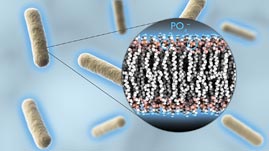Teachers' Domain - Digital Media for the Classroom and Professional Development
User: Preview

Source: Produced by WGBH and Digizyme, Inc.



In this animation produced by WGBH and Digizyme, Inc., learn about bacterial transformation, the process by which DNA plasmids are introduced into a bacterial cell’s genome. The animation presents the physical challenges of getting the plasmids through the cell’s plasma membrane and the “heat shock” technique used to overcome them. It also shows how researchers test for successful transformations using experimental and negative control plates.
Under normal conditions, bacteria reproduce by simply dividing into two cells—a process called binary fission. The two daughter cells are genetically identical to one another. However, there are mechanisms in nature that introduce new genes into bacteria. One of them is called transformation. Transformation is the process through which DNA from a bacterial cell’s environment is introduced into the cell. This might occur as one bacterial cell dies and releases its contents, and another living bacterial cell comes along and incorporates spilled DNA into its own genome. Taking up new genetic material can provide the living bacteria with survival advantages. For example, some species of bacteria have developed antibiotic resistance by becoming transformed with DNA from resistant species.
While transformation in nature is rare, researchers have developed experimental techniques to introduce small circular pieces of DNA called plasmids into a bacterial cell. Plasmids exist outside of the main bacterial chromosome and carry their own genes for specialized functions. They can be genetically altered so that if plasmids are taken up by bacterial cells, the cells will carry out a specific function. In the case of the lab portrayed in the animation, the genetic instruction is to make a genetically modified red fluorescent protein (mFP). The technique can also be used to get bacteria to produce human medicines and other important proteins.
In order for a bacterium to take in foreign DNA, the plasmid must pass through the bacterium’s cell wall and then the plasma membrane. To facilitate this, researchers use a chemical treatment to make the cells competent, or able to take up foreign DNA. The process alters the bacteria’s plasma membranes in such a way that plasmids can pass through them more readily. Several techniques may be used to make bacterial cells competent, including one that uses calcium chloride.
Because plasmid DNA contains phosphate groups, it is negatively charged. And because the plasma membranes surrounding the E. coli cell also contain phosphate groups, they, too, are negatively charged. To overcome the repelling force of the two negative electrical charges, researchers use a solution of calcium chloride to neutralize the negative charges.
Then, in a process called heat shock, the plasmid can pass through the cell wall and plasma membrane with a pressure differential created by a temperature change. By icing the bacteria and plasmids and then putting them in warm water, it is thought the resulting “heat shock” creates a slight pressure difference between the outside and the inside of the bacterial cell that makes the cell wall and membrane more permeable. This, in turn, helps move the plasmid from the outside to the inside of the bacterial cell.
 Loading Standards
Loading Standards